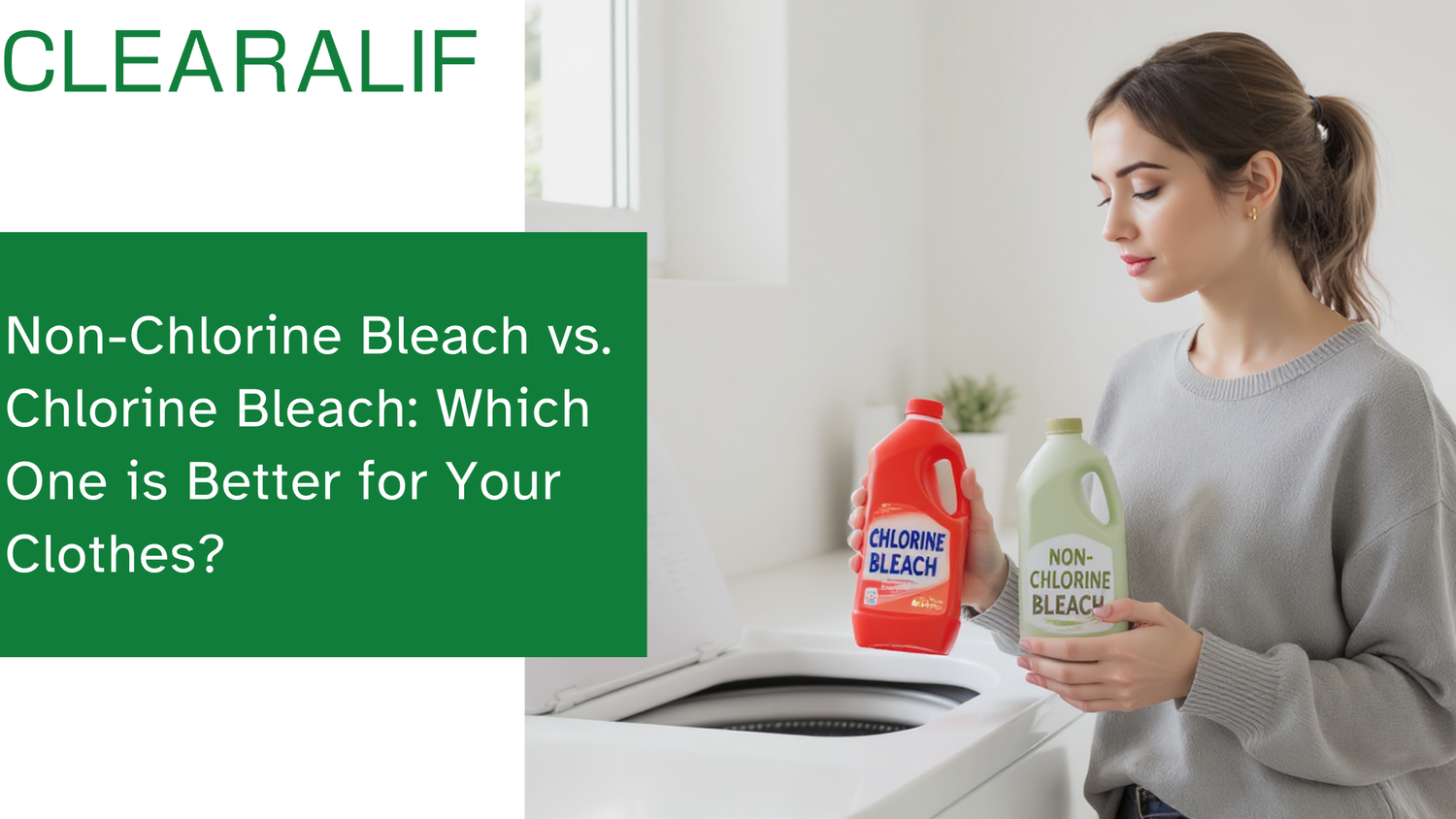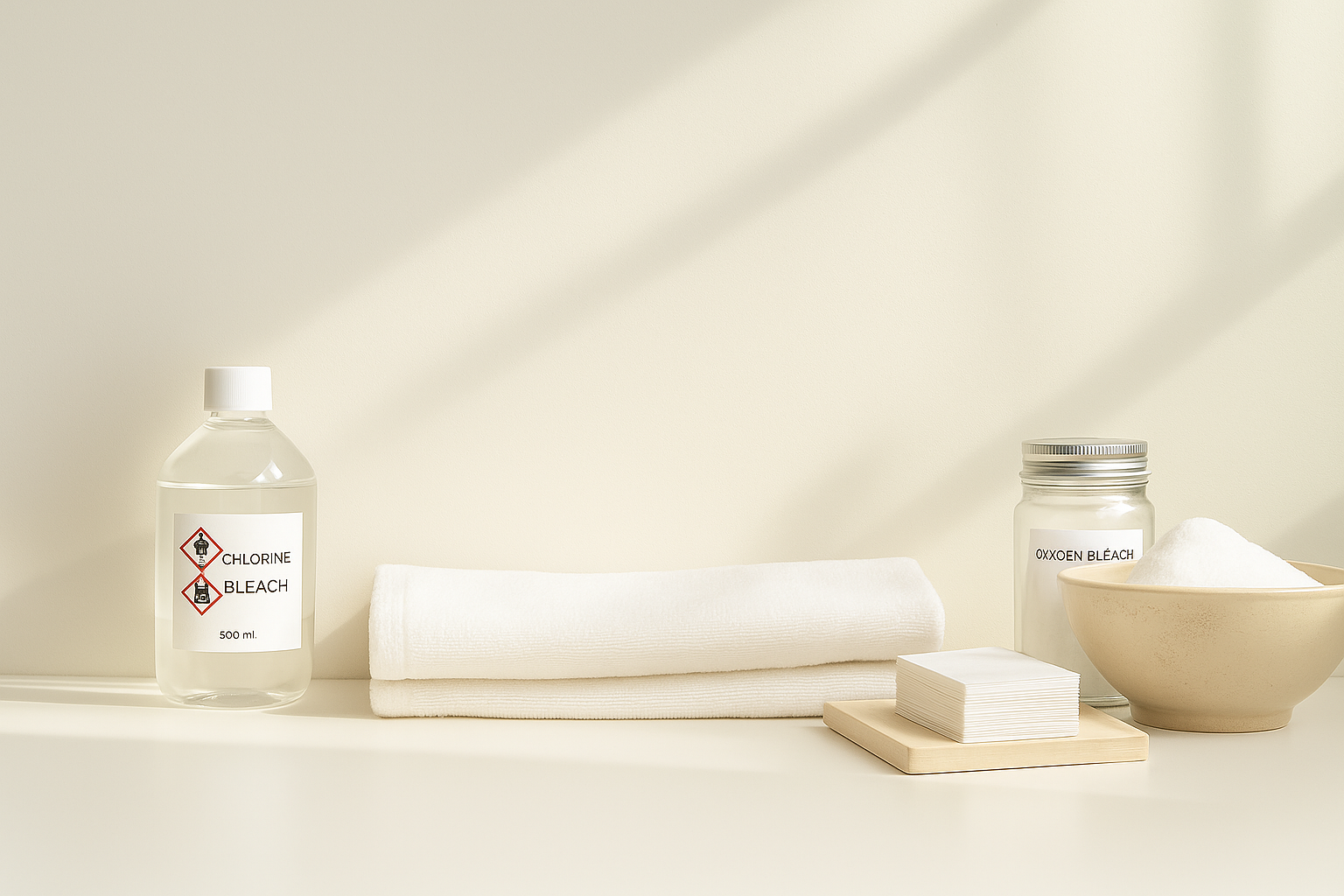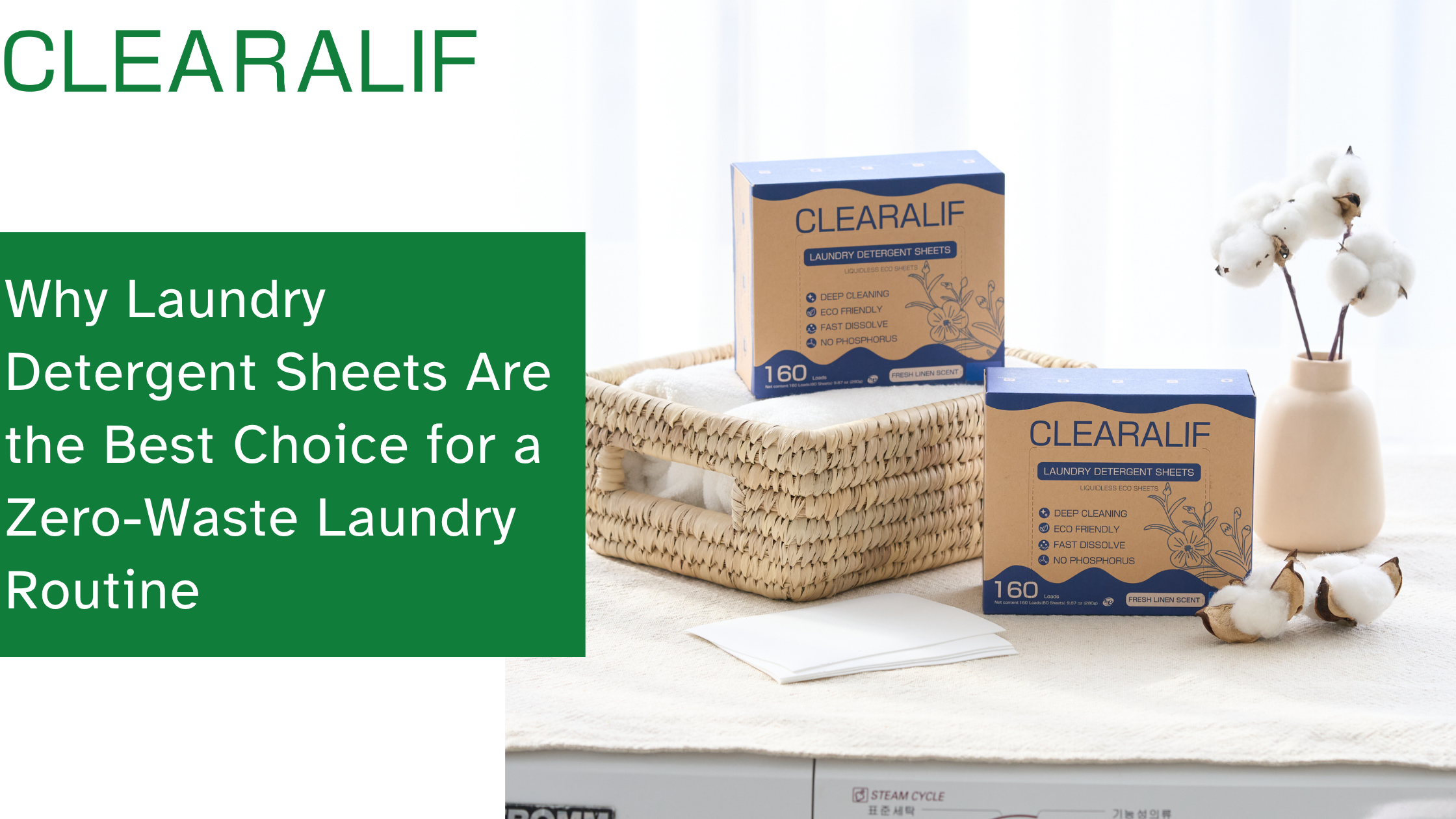Ever find yourself standing in your laundry room, unsure which bleach to choose? Or maybe you’re worried about damaging your favorite clothes or harming your family’s health? Let’s explore the difference between chlorine bleach and non-chlorine bleach to help you make the best decision for your home.
What is Chlorine Bleach? Strong but Harsh on Fabrics
You’ve probably come across chlorine bleach in most stores and laundry rooms—it’s the go-to “heavy-duty cleaner” that many people rely on for tough stains. It’s made mostly of sodium hypochlorite mixed with water, usually at 3-6% strength. This chemical gives chlorine bleach its strong smell and powerful cleaning ability.
People use chlorine bleach for removing stains, whitening fabrics, and killing germs on surfaces around the house. In the laundry room, it’s great for tough stains and making dingy white clothes look bright again.
What’s Good About Chlorine Bleach:
- Removes tough stains: It’s excellent at breaking down sweat, food, and body fluid stains.
- Kills germs: It destroys bacteria, viruses, and other harmful germs.
- Works fast: You can see results quickly, which is great for emergency stain removal.
What’s Not So Good:
- Damages fabrics: The strong chemicals can weaken fabric fibers over time, making clothes wear out faster.
- Ruins colors: It can strip the color from any fabric, leaving you with a discolored shirt that was once your favorite. Ever been frustrated by bleach ruining your colored clothes? You’re not alone!
- Makes fabrics deteriorate: Regular use can make white clothes turn yellow and fall apart sooner.
Have you ever felt frustrated when chlorine bleach ruined your favorite colored shirt? Don’t worry—there’s a better option!

What is Non-Chlorine Bleach? Gentle and Eco-Friendly
Non-chlorine bleach (also called oxygen bleach or color-safe bleach) is a much gentler way to clean and brighten your clothes. If you want to clean your clothes without worrying about fading colors or fabric damage, non-chlorine bleach could be your ideal option.
Non-chlorine bleach uses hydrogen peroxide or sodium percarbonate as its main ingredient. This makes it a much gentler alternative compared to chlorine bleach. These oxygen-based ingredients work differently—they release oxygen to lift stains and brighten fabrics without the harsh chemical action of chlorine.
Picture this: Your favorite colored shirt stays bright and fresh without any fear of losing its beautiful color. Non-chlorine bleach is eco-friendly and made with the environment and your skin in mind, making it a smart choice for families who want to avoid harsh chemicals.
So, what makes non-chlorine bleach such a great choice?
- Gentler on fabrics: The oxygen-based formula is less likely to damage or weaken fabric fibers.
- Safe for colors: It can brighten colored clothes without stripping away their dyes.
- Better for sensitive skin: Much less likely to cause irritation or allergic reactions.
- Environmentally friendly: Breaks down into harmless water and oxygen.
What’s Not as Strong:
- Milder stain removal: Might need longer treatment time or several applications for really tough stains.
- Less germ-killing power: Although it has some antibacterial effects, it’s not quite as powerful a disinfectant as chlorine bleach.
Are you looking for a cleaning method that protects both your clothes and the environment? Non-chlorine bleach is your answer!
Chlorine Bleach vs. Non-Chlorine Bleach: Key Differences
Not sure which type of bleach to choose? This chart summarizes the key differences between chlorine and non-chlorine bleach.

This side-by-side comparison offers a quick visual reference for choosing the right bleach based on fabric safety, cleaning strength, and environmental impact.
Understanding the main differences between these two bleaches will help you make the right choice for your specific laundry needs and lifestyle.
Cleaning Power:
When it comes to pure cleaning strength, chlorine bleach usually wins for removing stubborn, set-in stains and getting that bright white look. However, don’t underestimate non-chlorine bleach—it’s very effective for regular cleaning and can handle most common stains when used properly and given enough time.
Fabric Safety:
This is where non-chlorine bleach really shines. Its gentle formula means you can safely use it on many different fabrics, including delicate materials, colored clothes, and synthetic blends. Chlorine bleach, on the other hand, should only be used on white, bleach-safe fabrics because it can cause permanent damage to colors and certain fabric types.
Environmental Impact:
The environmental differences are significant. Chlorine bleach can create harmful byproducts when it mixes with organic matter in water systems, potentially making compounds that are toxic to water life. Non-chlorine bleach breaks down into just water and oxygen, making it a much more responsible choice for eco-conscious families.
Health Considerations:
If you have kids or anyone in the family with allergies or asthma, this choice becomes even more important. Imagine not having to worry about harmful chemicals while your little ones run around in freshly cleaned clothes. Chlorine bleach can trigger breathing problems, skin irritation, and other health issues, especially in closed spaces. It also creates dangerous chlorine gas when mixed with other household chemicals. Non-chlorine bleach is generally much safer, producing fewer fumes and being less likely to cause bad reactions.
For families with little ones, choosing non-chlorine bleach just makes sense, right? It gives you peace of mind knowing their clothes are safe and fresh.
When to Use Chlorine Bleach: Smart Choices for Specific Needs
Even with its drawbacks, there are specific times when chlorine bleach is still the most effective choice. Knowing when to use it—and how to use it safely—can help you get the most benefits while minimizing risks.
Best Times to Use It:
- White cotton linens: Bed sheets, towels, and washcloths that have become dingy or stained.
- Heavily soiled white clothes: Work clothes, sports uniforms, or clothes with set-in stains.
- When you need to disinfect: During illness or for items that need medical-grade cleanliness.
Safety Tips:
Always dilute chlorine bleach according to the package directions—never use it straight. Make sure you have good ventilation when using it, and never mix it with other cleaning products. Test it on a hidden area first, and always add bleach to water, not water to bleach, to prevent dangerous reactions. Wear gloves to protect your skin, and consider using it only occasionally rather than as a regular routine.
When to Use Non-Chlorine Bleach: Perfect for Daily Laundry
Non-chlorine bleach offers versatility and safety that makes it suitable for a much wider range of laundry situations, perfectly matching modern eco-conscious and health-aware lifestyles.
Best Times to Use It:
- Colored clothes: Safely brighten and refresh colored clothes without fear of fading.
- Delicate fabrics: Silk, wool, and other sensitive materials that need gentle care.
- Mixed loads: When you’re washing whites and colors together.
- Regular maintenance: Preventing dullness and keeping clothes looking fresh.
- Eco-conscious homes: When environmental impact is your main concern.
Non-chlorine bleach is a great option for people who want effective cleaning without compromising on fabric care or environmental responsibility.
Alternatives to Traditional Bleaches: Natural and Innovative Options
For those seeking even more natural and eco-friendly options, several alternatives can provide effective cleaning and brightening power without relying on commercial bleaching agents.
Natural Options:
Baking soda works as a gentle whitener and deodorizer that’s safe for all fabrics and completely natural. White vinegar can help remove soap buildup and naturally brighten clothes while being harmless to the environment. Lemon juice offers natural bleaching properties for white fabrics when combined with sunlight.
Innovative Eco-Friendly Products:
Modern eco-conscious brands have developed innovative solutions that combine effectiveness with environmental responsibility. These alternatives often use plant-based enzymes and oxygen-based brighteners that provide excellent results while maintaining a commitment to environmental sustainability.
Make the Right Choice for Your Clothes and the Planet

The choice between chlorine bleach and non-chlorine bleach ultimately depends on your specific needs, fabric types, and personal values. Chlorine bleach is still unmatched for heavy-duty whitening and disinfection of appropriate fabrics, but its harsh nature and environmental impact make it less suitable for regular use or eco-conscious households.
Non-chlorine bleach emerges as the more versatile and responsible choice for most modern laundry needs. Its gentleness on fabrics, safety for colored clothing, reduced health risks, and environmental friendliness make it an excellent default option for routine laundry care. While it may require a bit more patience for the toughest stains, the trade-off in fabric longevity, safety, and environmental impact often makes it the better choice.
For the best of both worlds, consider keeping both types on hand: non-chlorine bleach for regular use and fabric care, and chlorine bleach reserved for occasional heavy-duty cleaning of white, bleach-safe items when maximum stain removal is essential.

Share Your Experience and Embrace Better Choices
We’d love to hear about your experiences with different bleach products! Have you made the switch to non-chlorine bleach, or do you still rely on traditional chlorine bleach for certain situations? Share your laundry tips and tricks in the comments below!
Looking to avoid bleach altogether? Shop our eco-friendly laundry collection and take the next step toward a safer laundry routine.
Frequently Asked Questions (FAQ)
1. Q: Is non-chlorine bleach the same as color-safe bleach?
A: Yes, non-chlorine bleach is often labeled as “color-safe bleach.” It typically contains oxygen-based ingredients like hydrogen peroxide or sodium percarbonate that clean and brighten without removing fabric dyes.
2. Q: Can I mix bleach with other laundry products like detergent or fabric softener?
A: You can use bleach and detergent together in the same wash cycle, but never mix bleach with vinegar, ammonia, or other household cleaners, as it can produce toxic fumes. Always follow your product’s label instructions carefully.
3. Q: Is it okay to use chlorine bleach on colored clothes if I dilute it?
A: No. Even when diluted, chlorine bleach can strip color from dyed fabrics. It’s best to avoid using chlorine bleach on anything other than white, bleach-safe items.
4. Q: Which type of bleach is better for people with sensitive skin?
A: Non-chlorine bleach is generally safer for people with sensitive skin or allergies. It produces fewer fumes and is less likely to cause irritation compared to chlorine bleach.
5. Q: Can non-chlorine bleach disinfect like chlorine bleach?
A: While non-chlorine bleach may have mild antibacterial properties, it does not disinfect to the same level as chlorine bleach. For sanitizing purposes, chlorine bleach is more effective—but should be used with caution.







Leave a comment
This site is protected by hCaptcha and the hCaptcha Privacy Policy and Terms of Service apply.